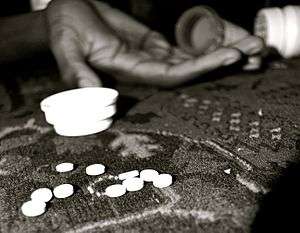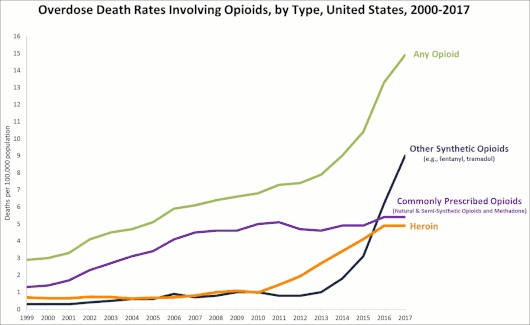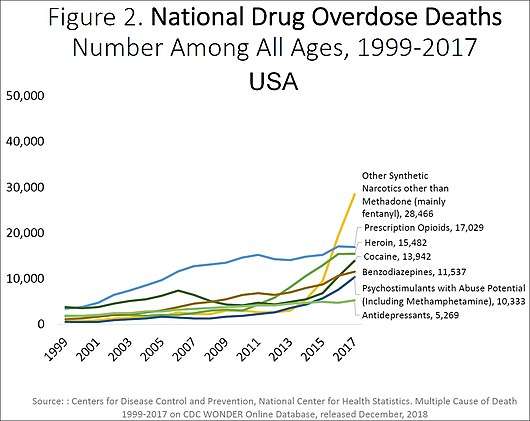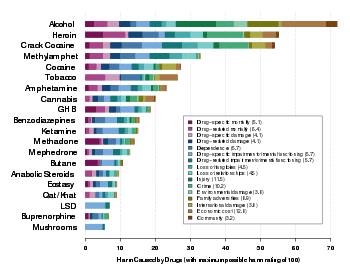Drug overdose
A drug overdose (overdose or OD) is the ingestion or application of a drug or other substance in quantities greater than are recommended.[1][2] Typically it is used for cases when a risk to health will potentially result.[1] An overdose may result in a toxic state or death.[2]
| Drug overdose | |
|---|---|
| Other names | Overdose, OD, Hotshot, Wasted, Intoxication, Gassed |
 | |
| Specialty | Toxicology |
| Symptoms | Depends on the drug and the amount used |
| Complications | Brain death, coma, neurological damage, heart failure, suicide |
| Causes | Addiction, depression, anxiety, suicidal ideation |
| Risk factors | Trauma, physical abuse, sexual abuse, child abuse, bullying |
| Medication | Activated charcoal, stomach pump |
Classification

The word "overdose" implies that there is a common safe dosage and usage for the drug; therefore, the term is commonly applied only to drugs, not poisons, even though many poisons as well are harmless at a low enough dosage. Drug overdose is caused to commit suicide, the result of intentional or unintentional misuse of medication. Intentional misuse leading to overdose can include using prescribed or unprescribed drugs in excessive quantities in an attempt to produce euphoria.
Usage of illicit drugs, in large quantities, or after a period of drug abstinence can also induce overdose. Cocaine users who inject intravenously can easily overdose accidentally, as the margin between a pleasurable drug sensation and an overdose is small.[4] Unintentional misuse can include errors in dosage caused by failure to read or understand product labels. Accidental overdoses may also be the result of over-prescription, failure to recognize a drug's active ingredient or unwitting ingestion by children.[5] A common unintentional overdose in young children involves multi-vitamins containing iron.
The term 'overdose' is often misused as a descriptor for adverse drug reactions or negative drug interactions due to mixing multiple drugs simultaneously.
Signs and symptoms
| Symptoms | Blood pressure | Heart rate | Respiratory rate | Temperature | Pupils | Bowel sounds | Diaphoresis |
|---|---|---|---|---|---|---|---|
| Anticholinergic | ~ | up | ~ | up | dilated | down | down |
| Cholinergic | ~ | ~ | unchanged | unchanged | constricted | up | up |
| Opioid | down | down | down | down | constricted | down | down |
| Sympathomimetic | up | up | up | up | dilated | up | up |
| Sedative-hypnotic | down | down | down | down | ~ | down | down |
Signs and symptoms of an overdose vary depending on the drug or exposure to toxins. The symptoms can often be divided into differing toxidromes. This can help one determine what class of drug or toxin is causing the difficulties.
Symptoms of opioid overdoses include slow breathing, heart rate and pulse.[7] Opioid overdoses can also cause pinpoint pupils, and blue lips and nails due to low levels of oxygen in the blood. A person experiencing an opioid overdose might also have muscle spasms, seizures and decreased consciousness. A person experiencing an opiate overdose usually will not wake up even if their name is called or if they are shaken vigorously.
Causes
The drugs or toxins that are most frequently involved in overdose and death (grouped by ICD-10):
- Acute alcohol intoxication (F10)
- Ethyl alcohol
- Methanol poisoning
- Ethylene glycol poisoning
- Opioid overdose (F11)
- Among sedative-hypnotics (F13)
- Barbiturate overdose (T42.3)
- Benzodiazepine overdose (T42.4)
- Uncategorized sedative-hypnotics (T42.6)
- Ethchlorvynol (Placidyl)
- GHB
- Glutethimide (Doriden)
- Methaqualone
- Ketamine (T41.2)
- Among stimulants (F14-F15)
- Cocaine overdose (T40.5)
- Amphetamine overdose (T43.6)
- Methamphetamine overdose (T43.6)
- Among tobacco (F17)
- Nicotine poisoning (T65.2)
- Among poly drug use (F19)
- Drug "cocktails" (speedballs)
- Medications
- Aspirin poisoning (T39.0)
- Paracetamol poisoning (Alone or mixed with oxycodone)
- Paracetamol toxicity (T39.1)
- Tricyclic antidepressant overdose (T43.0)
- Vitamin poisoning
- Pesticide poisoning (T60)
- Inhalants
Diagnosis
The substance that has been taken may often be determined by asking the person. However, if they will not, or cannot, due to an altered level of consciousness, provide this information, a search of the home or questioning of friends and family may be helpful.
Examination for toxidromes, drug testing, or laboratory test may be helpful. Other laboratory test such as glucose, urea and electrolytes, paracetamol levels and salicylate levels are typically done. Negative drug-drug interactions have sometimes been misdiagnosed as an acute drug overdose, occasionally leading to the assumption of suicide.[8]
Prevention
The distribution of naloxone to injection drug users and other opioid drug users decreases the risk of death from overdose.[9] The Centers for Disease Control and Prevention (CDC) estimates that U.S. programs for drug users and their caregivers prescribing take-home doses of naloxone and training on its utilization are estimated to have prevented 10,000 opioid overdose deaths.[10] Healthcare institution-based naloxone prescription programs have also helped reduce rates of opioid overdose in the U.S. state of North Carolina, and have been replicated in the U.S. military.[11][12] Nevertheless, scale-up of healthcare-based opioid overdose interventions is limited by providers' insufficient knowledge and negative attitudes towards prescribing take-home naloxone to prevent opioid overdose.[13] Programs training police and fire personnel in opioid overdose response using naloxone have also shown promise in the U.S.[14]
Management

Stabilization of the victim's airway, breathing, and circulation (ABCs) is the initial treatment of an overdose. Ventilation is considered when there is a low respiratory rate or when blood gases show the person to be hypoxic. Monitoring of the patient should continue before and throughout the treatment process, with particular attention to temperature, pulse, respiratory rate, blood pressure, urine output, electrocardiography (ECG) and O2 saturation.[15] Poison control centers and medical toxicologists are available in many areas to provide guidance in overdoses both to physicians and to the general public.
Antidotes
Specific antidotes are available for certain overdoses. For example, naloxone is the antidote for opiates such as heroin or morphine. Similarly, benzodiazepine overdoses may be effectively reversed with flumazenil. As a nonspecific antidote, activated charcoal is frequently recommended if available within one hour of the ingestion and the ingestion is significant.[16] Gastric lavage, syrup of ipecac, and whole bowel irrigation are rarely used.[16]
Epidemiology and statistics
From 1999 to Feb 2019 in the United States, more than 770,000 people have died from drug overdoses.[17]
In the United States, 70,200 people died from drug overdoses in 2017, which was an increase of about ten percent over 2016.[18][19] Since 2000, the U.S. drug overdose death rate has gone from 6.2 per 100,000 people in 2000 to 21.0 per 100,000 in 2018.[20][21]
The National Center for Health Statistics reports that 19,250 people died of accidental poisoning in the U.S. in the year 2004 (eight deaths per 100,000 population).[22]
In 2008 testimony before a Senate subcommittee, Leonard J. Paulozzi,[23] a medical epidemiologist at the Centers for Disease Control and Prevention said that in 2005 more than 22,000 American lives were lost due to overdoses, and the number is growing rapidly. Paulozzi also testified that all available evidence suggests unintentional overdose deaths are related to the increasing use of prescription drugs, especially opioid painkillers.[24] However, the vast majority of overdoses are also attributable to alcohol. It is very rare for a victim of an overdose to have consumed just one drug. Most overdoses occur when drugs are ingested in combination with alcohol.[25]
Drug overdose was the leading cause of injury death in 2013. Among people 25 to 64 years old, drug overdose caused more deaths than motor vehicle traffic crashes. There were 43,982 drug overdose deaths in the United States in 2013. Of these, 22,767 (51.8%) were related to prescription drugs.[26]
The 22,767 deaths relating to prescription drug overdose in 2013, 16,235 (71.3%) involved opioid painkillers, and 6,973 (30.6%) involved benzodiazepines. Drug misuse and abuse caused about 2.5 million emergency department (ED) visits in 2011. Of these, more than 1.4 million ED visits were related to prescription drugs. Among those ED visits, 501,207 visits were related to anti-anxiety and insomnia medications, and 420,040 visits were related to opioid analgesics.[27]
 U.S. yearly overdose deaths from all drugs.[18]
U.S. yearly overdose deaths from all drugs.[18] U.S. yearly overdose deaths involving benzodiazepines.[18]
U.S. yearly overdose deaths involving benzodiazepines.[18]




See also
| Wikimedia Commons has media related to Drug-related death statistics. |
References
- Definitions Archived 2011-02-27 at the Wayback Machine Retrieved on 20 September 2014.
- "Stairway to Recovery: Glossary of Terms" Archived 2011-07-09 at the Wayback Machine[Positional parameters ignored].
- NCHS Data Visualization Gallery—Drug Poisoning Mortality. From National Center for Health Statistics. Open the dashboard dropdown menu and pick "U.S. Trends". From the menus on the right pick all races, all ages, and both sexes. Run your cursor over the graph to see the data.
- Study on fatal overdose Archived 2012-01-19 at the Wayback Machine in New-York City 1990-2000, visited May 11, 2008,
- "What to do with leftover medicines". Medicines Talk, Winter 2005. Available at "Archived copy". Archived from the original on 2009-10-24. Retrieved 2010-01-06.CS1 maint: archived copy as title (link)
- Goldfrank, Lewis R. (1998). Goldfrank's toxicologic emergencies. Norwalk, CT: Appleton & Lange. ISBN 0-8385-3148-2.
- Chandler, Stephanie. "Symptoms of an opiate overdose". Live Strong. Archived from the original on 18 April 2012. Retrieved 17 May 2012.
- "Column—Fatal Drug-Drug Interaction As a Differential Consideration in Apparent Suicides" Archived 2008-02-23 at the Wayback Machine.
- Piper TM; Stancliff S; Rudenstine S; et al. (2008). "Evaluation of a naloxone distribution and administration program in New York City". Subst Use Misuse. 43 (7): 858–870. doi:10.1080/10826080701801261. hdl:2027.42/60330. PMID 18570021.
- "Community-Based Opioid Overdose Prevention Programs Providing Naloxone—United States, 2010". Centers for Disease Control and Prevention. December 2010. Archived from the original on 2017-09-09.
- Albert S, Brason FW 2nd, Sanford CK, Dasgupta N, Graham J, Lovette B. (June 2011). "Project Lazarus: community-based overdose prevention in rural North Carolina". Pain Medicine. 12 Suppl 2: S77–85. doi:10.1111/j.1526-4637.2011.01128.x. PMID 21668761.CS1 maint: multiple names: authors list (link)
- Beletsky L, Burris S, Kral AH (July 2009). "Closing Death's Door: Action Steps to Facilitate Emergency Opioid Drug Overdose Reversal in the United States". Center for Health Law, Policy and Practice, Temple University School of Law. doi:10.2139/ssrn.1437163. SSRN 1437163.
- Beletsky L, Ruthazer R, Macalino GE, Rich JD, Tan L, Burris S (January 2007). "Physicians' knowledge of and willingness to prescribe naloxone to reverse accidental opiate overdose: challenges and opportunities". Journal of Urban Health. 84 (1): 126–36. doi:10.1007/s11524-006-9120-z. PMC 2078257. PMID 17146712.
- Lavoie D. (April 2012). "Naloxone: Drug-Overdose Antidote Is Put In Addicts' Hands". Huffington Post. Archived from the original on 2012-05-18.
- Longmore, Murray; Ian Wilkinson; Tom Turmezei; Chee Kay Cheung (2007). Oxford Handbook of Clinical Medicine. United Kingdom: Oxford. ISBN 978-0-19-856837-7.
- Vanden Hoek, TL; Morrison, LJ; Shuster, M; Donnino, M; Sinz, E; Lavonas, EJ; Jeejeebhoy, FM; Gabrielli, A (Nov 2, 2010). "Part 12: cardiac arrest in special situations: 2010 American Heart Association Guidelines for Cardiopulmonary Resuscitation and Emergency Cardiovascular Care". Circulation. 122 (18 Suppl 3): S829–61. doi:10.1161/CIRCULATIONAHA.110.971069. PMID 20956228.
- STATCAST—Week of September 9, 2019. NCHS Releases New Monthly Provisional Estimates on Drug Overdose Deaths. National Center for Health Statistics.
- Overdose Death Rates. And Archived 2015-11-28 at the Wayback Machine. By National Institute on Drug Abuse.
- Sanger-Katz, Margot (2018-08-15). "Bleak New Estimates in Drug Epidemic: A Record 72,000 Overdose Deaths in 2017". The New York Times. Retrieved 2018-08-16.
- Increases in Drug and Opioid Overdose Deaths—United States, 2000–2014. Archived 2017-03-04 at Archive.today Morbidity and Mortality Weekly Report from the Centers for Disease Control and Prevention (CDC). January 1, 2016 article.
- Products—Vital Statistics Rapid Release—Provisional Drug Overdose Data. CDC. Scroll down the page and click on the dropdown data table called "Data Table for Figure 1a. 12 Month-ending Provisional Counts of Drug Overdose Deaths". The 2018 number is the "predicted value" for the 12 month period ending Jan 2019. That number changes as more info comes in. U.S. Census Bureau QuickFacts: United States. Has July 1, 2018 resident population. Used to calculate rate.
- Referral Page—FASTSTATS—Accidents or Unintentional Injuries Archived 2017-07-15 at the Wayback Machine Retrieved on 20 September 2014.
- CDC Expert, Leonard J. Paulozzi, MD, MPH Archived 2014-02-20 at the Wayback Machine Retrieved on 20 September 2014.
- CDC Washington Testimony March 5, 2008 Archived July 15, 2017, at the Wayback Machine Retrieved on 20 September 2014.
- "The Persistent, Dangerous Myth of Heroin Overdose" Archived 2015-03-23 at the Wayback Machine.
- "Understanding the Epidemic | Drug Overdose | CDC Injury Center" Archived 2017-09-09 at the Wayback Machine.
- "Prescription Opioid Overdose Data | Drug Overdose | CDC Injury Center" Archived 2017-01-18 at the Wayback Machine.
- Opioid Data Analysis and Resources. Drug Overdose. CDC Injury Center. Centers for Disease Control and Prevention. Click on "Rising Rates" tab for a graph. See data table below the graph.
Further reading
- Nelson, Lewis H.; Flomenbaum, Neal; Goldfrank, Lewis R.; Hoffman, Robert Louis; Howland, Mary Deems; Neal A. Lewin (2015). Goldfrank's toxicologic emergencies. New York: McGraw-Hill, Medical Pub. Division. ISBN 978-0-07-143763-9.
- Olson, Kent C. (2004). Poisoning & drug overdose. New York: Lange Medical Mooks/McGraw-Hill. ISBN 0-8385-8172-2.
